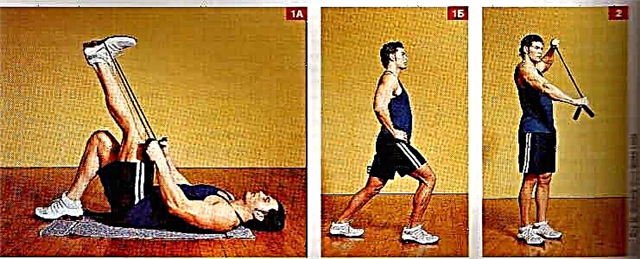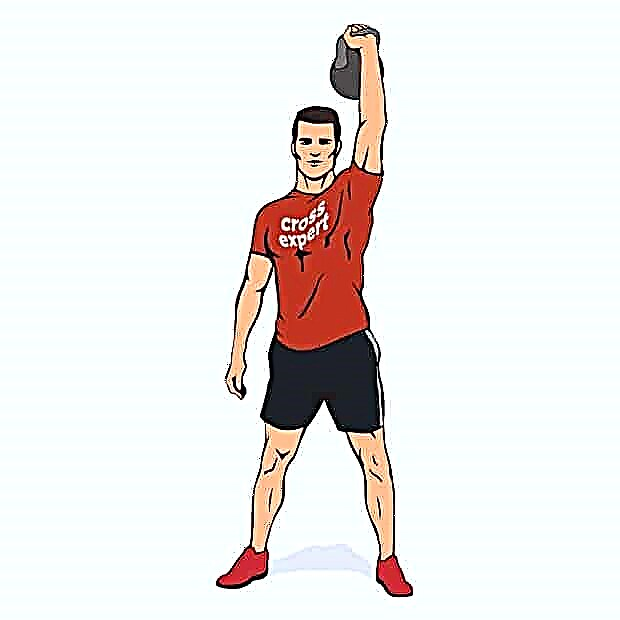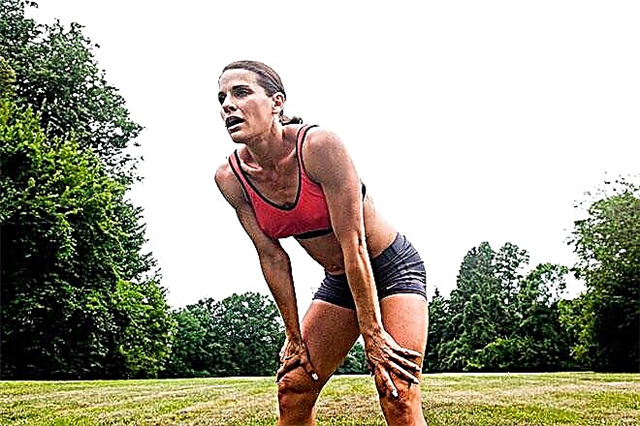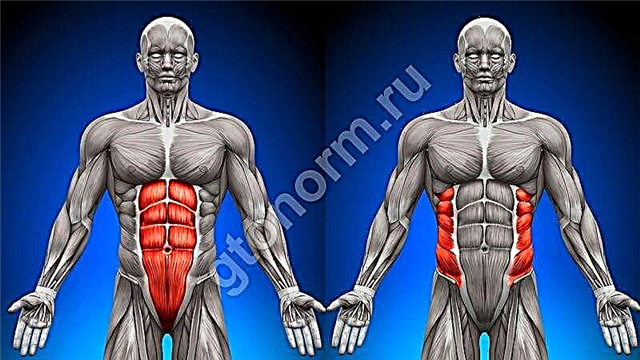Two-handed kettlebell swing is an exercise that came to CrossFit from kettlebell lifting. And if in kettlebell lifting the performance of this exercise is of an auxiliary nature for the development of strength and endurance in exercises such as the snatch and jerk of kettlebells, then in functional training its purpose is somewhat different.
Two-handed kettlebell swing is a basic exercise that involves almost all muscle groups, increases the explosive strength of the legs and shoulder girdle, and when combined with other basic exercises within one complex, it contributes to a colossal increase in strength endurance.
Today we will discuss the following points:
- Why is it used?
- What muscle groups does this exercise involve?
- The technique of performing the exercise and errors that occur during execution.
- The benefits of this exercise.
- Crossfit complexes, which include two-handed kettlebell swings.
What is this exercise for?
Kettlebells are a great tool for the true CrossFit athlete and can take your workouts to the next level of intensity. One of the exercises that we highly recommend including in your arsenal is just two-handed kettlebell swings. This is a relatively simple exercise in terms of proper technique, and is definitely suitable for those athletes who are just starting to get acquainted with such a discipline as CrossFit. With this exercise, you will develop good explosive strength in your hips and glutes, which will be a huge plus as your fitness level rises and you start doing exercises such as sumo deadlifts, front squats and jerk barbell jerks with decent weights.
Which muscle groups use two-handed kettlebell swings? The quadriceps, hamstrings and gluteal muscles, as well as the lumbar back, take over the main work. The movement is explosive, most of the amplitude of the kettlebell passes by inertia, and only the last 20-30% of the amplitude of the projectile passes due to the effort of the deltoid muscles, especially the anterior beam. The abdominals and extensors of the spine are under static tension throughout the exercise. Also, two-handed kettlebell swings develop good grip strength if you perform an exercise with a kettlebell weighing 24 kg or more. Your hands and forearms will definitely benefit from this, a steel handshake is guaranteed.

Execution technique
So we got to the most important thing - the technique of performing kettlebell swings with both hands. Let's take this exercise down to the bottom, starting from the starting position, ending with its top point.
Starting position
Let's traditionally start from the starting position:
- The legs are slightly wider than the shoulders.
- Socks are spaced 45 degrees to the sides.
- The feet are firmly pressed to the floor.
- The center of gravity lies on the heels.
- The pelvis is laid back, the back is perfectly straight.
- Do not tilt your head down and do not bend your neck back; your gaze should be directed strictly in front of you. The kettlebell is on the floor between your legs.
Correct execution of the movement
We tear off the kettlebell from the floor and make a small swing back towards the gluteal muscles. A slight forward tilt of the body is allowed, but the back must remain straight throughout the entire movement, it is unacceptable to round it.

As the kettlebell begins to lower by inertia, we make a powerful effort with our legs and gluteal muscles. The knee joint is straightened, the pelvis is pulled forward. The center of gravity is shifted from the heels to the middle of the foot. The movement should be powerful and fast, but not sharp, it is important to understand the biomechanics of the movement, for this it is recommended to start this exercise with a low weight for a large number of repetitions.
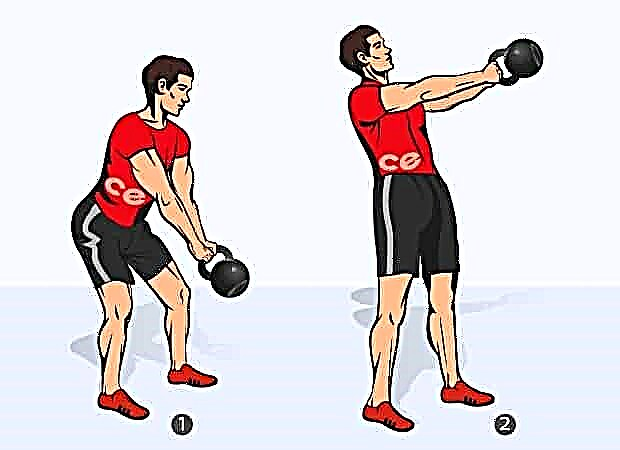
If the movement is done correctly, the weight should “fly up” in front of you. Usually, the inertial force is enough until the kettlebell reaches the level of the solar plexus, then the front deltas should be included in the work and the kettlebell should be brought to shoulder or chin level. From this position, the projectile drops down to about knee height, winds up slightly behind the heels, and another rep is performed.
Typical mistakes
Next, we will analyze the most common mistakes when performing two-handed kettlebell swings.
- The range of motion does not imply the lifting of the kettlebell over the head, since such a vector of motion is anatomically inconvenient for the shoulder joint and ligaments. The correct way to do the exercise is to bring the kettlebell to the level of the shoulder girdle or chin.
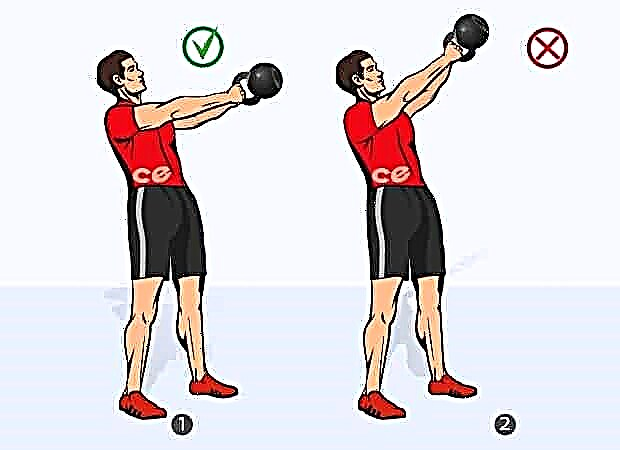
- It is not recommended to relax the buttocks at the top point, otherwise the lowering of the projectile down will turn out to be more abrupt, and control over the movement will be lost.
- Do not lift your heels off the floor while doing the exercise. This will entail a loss of control over your movement, a heavy kettlebell will start to “outweigh” you, and your back will be rounded, which is fraught with injury.
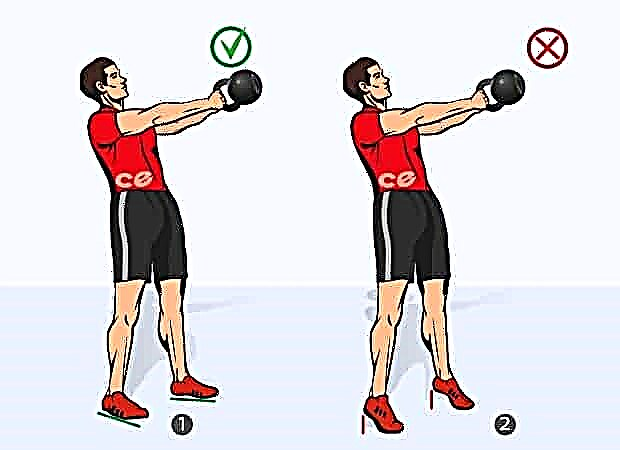
- Do not start the exercise if you have pain or discomfort in the lumbar spine or shoulders. Wait for a complete recovery, otherwise the situation can easily worsen, and the recovery process can take up to several months.
- Do not start the exercise without doing the warm-up properly. Pay special attention to the lumbar and cervical spine, knee and shoulder joints.
- Perform the exercise in loose, non-tight clothing. Due to the fact that the movement itself is quite fast and explosive, the seams on your pants or shorts can easily come apart. It would seem nonsense, but who wants to walk around the gym in torn clothes?
The benefits of exercise
Two-handed kettlebell swing is a useful multifunctional exercise, at the same time responsible for the explosive strength of the legs, the retention of static tension in the muscles of the core, the development of strength endurance and grip strength. For these reasons, this exercise has gained immense popularity not only in crossfit and kettlebell lifting, but also in mixed martial arts, Brazilian jiu-jitsu, grappling and other types of martial arts. Some fitness and bodybuilding athletes also include this exercise in their training program, which leads to an increase in strength in such common exercises as classic and front squats with a barbell, deadlift, military barbell press, shrugs and others. Therefore, the benefits of kettlebell swing cannot be overstated.
Crossfit complexes
A small selection of crossfit complexes in which two-handed kettlebell swings are involved. Take note!
| FGS | Perform 10 shvungs with weights, 10 burpees, 10 swings with a kettlebell with both hands, 10 crunches per press. |
| Funbobbys Filthy 50 | Perform 50 pull-ups, 50 deadlifts, 50 push-ups, 50 two-handed kettlebell swings, 50 barbell squats, 50 kettlebell shwungs, 50 dumbbell lunges. |
| Iron man | Perform 20-10-5 barbell thrusters, two-handed kettlebell swings, barbell jerks and kettlebell pulls to the chin. |
| Lazy | Perform 50 kettlebell jerks, 50 kettlebell jerks and 50 kettlebell swings with both hands. |
| SSDD | Perform 10 burpees, 20 deadlifts, 40 push-ups and 60 two-handed kettlebell swings. |
With the help of these and other complexes not mentioned in the article, you can achieve the desired result and achieve serious achievements in CrossFit. An increase in explosive strength and strength endurance, as well as rapid fat burning (provided you follow the right diet) will not keep you waiting long. Moreover, these complexes are beneficial not only for your muscles and musculoskeletal system, but also for the entire cardiovascular system, as they combine elements of aerobic and anaerobic load.
There are still questions about the exercise - wackle in the comments. Liked? Share the material with your friends on social networks! 😉



